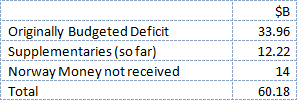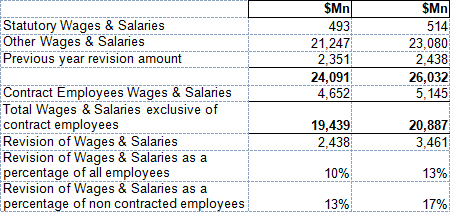Introduction
As campaign 2011 moves into top gear, no one it seems has the least interest in the financial and economic consequences of the explosion in what appears to be uncontrolled expenditure by the government. The simple rule of financial management is that new expenditure must either come from increasing revenues, or from utilizing accumulated reserves or from new borrowings. That is as true of an individual as it is of a company or government. But the very simplicity of the rule may help to disguise the stark consequences of the option of overspending financed by borrowings.
Take Budget 2011 as a case in point. That budget presented in January this year showed significant increases in government spending over 2010. Current non-interest expenditure was projected to increase by $9B from $78.5B to $88B and capital expenditure from $47B to $62B. Not that these increases were justified by the funds available or by new or additional revenues. No. The Minister, recklessly in my view, proposed to the National Assembly a budget deficit of $34B financed by external borrowings of $32B and from domestic sources by $2B. Over all the protestations of the opposition, the government passed the Budget without a single modification.
Warning
At that time, Ram & McRae immediately sounded the warning bell pointing in its January 18 review of the Budget that:
– External debt service in 2011 would be US$28.8 million and domestic debt service $4.979 billion, an increase of 15.1% over the preceding year;
– The percentage of budgeted current revenue used to service debt had increased from 7.9% in 2007 to 13.3% in 2010; and
– The impact of the unrestrained expenditure would be an increase in the overall balance on the financial operations from a negative $20.5 billion in 2010 to a negative $33.9 billion in 2011, or 65%, and double that of 2009.
From all appearances, the situation is turning out to be much worse. Between January and September, the Minister of Finance presented to the National Assembly six financial papers for supplementary funds totalling $12.2 billion. A breakdown of the financial papers shows $5.449 billion coming out of the Contingencies Fund and $6.77 billion for proposed spending. Unless these are financed from new sources or increases in revenue the deficit would climb to $46B. But not only are these not coming from new sources or increases in revenue but President Jagdeo has now conceded that some $14B budgeted in 2011 as revenue flowing from the Guyana-Norway LCDS initiative is now certain not to be coming in this year.
No lame duck
If we add this all together this is what we find:
In this table, I am conservatively and unrealistically assuming that there will be no further supplementary appropriations for 2011. Of course there will be. The problem is that no one knows the extent of the unbudgeted spending that has been going on since the last financial paper was submitted to the National Assembly before it expired in late September. It did not help that the parliamentary opposition had withdrawn from the National Assembly although it might have made no difference since the government is not known for its willingness to listen to any criticism of its actions, whether on money or otherwise.
What it did was to allow the distinctly un-lame duck President Jagdeo and the openly politicized Finance Minister to do as they wished, to spend as they wanted and to ignore the consequences. Even now, or rather moreso now, the President goes around handing out millions to all and sundry which the post-November 28 administration will have to add up and then approach the National Assembly to approve what he has been spending, as if it were coming out of his presidential pension package.
Out-turn
Let us return to the out-turn for the year. And let us assume that the government manages to shave as much as ten billion dollars of expenditure from the budget for the year. Here are two immediate consequences:
The resulting deficit will be approximately $50 billion or US$250M – more than the entire sum receivable from Norway over a five year period.
The total debt of the country – external and internal – expressed in US dollars, will exceed US$1.8 billion, just a little below the debt the PPP/C inherited in 1992.
Because of the depreciation of the Guyana dollar since 1992 from $125 to $204 to the US dollar, the per capita debt, which is the amount of debt divided by the number of Guyanese, would be higher in 2011 than it was in 1992.
The consequences of this will be severe on the taxpayer. In 2010, the interest cost of servicing the domestic debt in 2010 was $3.9B while the interest on the external debt was $2B. Total debt service inclusive of interest cost is 13.28% of current revenue. While servicing of the external debt in 2011 is projected to increase by 27.6%, the internal debt service is projected to fall in 2011 because of a substantial projected decrease in domestic debt repayment. That is an apparently painless way to say that the government never intended to pay down on the domestic debt in 2011.
Mid-year hope
I was hoping that the Mid-Year report prepared by the Minister of Finance would have offered some comfort. Unfortunately, while the National Estimates include a table giving an accounting classification of the Central Government Financial Operations, the Mid-Year report does not. The narrative in the later report indicates that full-year 2011 revenues are projected to exceed 2010 by about $7 billion while for the first half of 2011 non-interest current expenditure amounted to $38.3 billion, an increase of 16.2 per cent over the same period last year. Similarly capital expenditure for the first half of 2011 amounted to $17 billion compared to $13.7 billion in the corresponding period in 2010.
One other possibility is that the new expenditure will come from one of the many slush funds or padded line items such as the provisions for wage increases dealt with in Business Page last week. The economy cannot bear the kind of debt burden which reckless spending involves.
New money
Earlier in this column reference was made to the financial papers for additional money for the government. The principal agencies for which monies were voted were:
The vote for GPL was a single amount for the acquisition of a 15.2 MW power plant at Kingston. The allocation for Ministry of Finance was to buy fuel for the LINMINE Community Power Plant, flood victims in regions 6 (?), 9 and 10 and $1.2 billion for additional electricity charges. One expects the Ministry of Finance to be best at budgeting costs and to have its allocation for the payment of electricity charges is a poor reflection of its ability to manage and control costs.
Public Works had much to do with road expansion on the East Bank and East Coast Demerara, preparation of the Supenaam and Parika Stellings for Chinese vessels and cost for replacement of ferry spares. Health was mainly for the purchase of drugs while Agriculture was for D&I and other projects, some of which are related to the Grow More Food Campaign which the government is trying hard to justify against the huge sums spent so far.
Conclusion
For now, ‘boat gone ah falls.’ The Jagdeo administration will soon expire and hopefully a government with some commitment to financial discipline will see the need to cap borrowings to levels that are sustainable. It is what the economy and the country will need to cushion any challenges which inevitably happen even to the best managed economy.


